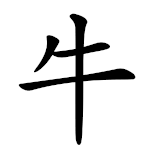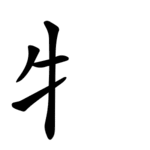| 牛 | ||
|---|---|---|
| ||
| 牛 (U+725B) "cow" | ||
| Pronunciations | ||
| Pinyin: | niú | |
| Bopomofo: | ㄋㄧㄡˊ | |
| Gwoyeu Romatzyh: | niou | |
| Wade–Giles: | niu2 | |
| Cantonese Yale: | ngàuh | |
| Jyutping: | ngau4 | |
| Pe̍h-ōe-jī: | giû | |
| Japanese Kana: | ギュウ gyū / ゴ go (on'yomi) うし ushi (kun'yomi) | |
| Sino-Korean: | 우 u | |
| Names | ||
| Chinese name(s): | (牜) 牛字旁 niúzìpáng (Bottom) 牛字底 niúzìdǐ | |
| Japanese name(s): | 牛/うし ushi (牜) 牛偏/うしへん ushihen | |
| Hangul: | 소 so | |
| Stroke order animation | ||
 | ||

Radical 93 or radical cow (牛部) meaning "cow" or "bulls" is one of the 34 Kangxi radicals (214 radicals total) composed of 4 strokes.
When appearing at the left side of a Chinese character, it transforms into 牜, with the last two strokes switching their order and the last stroke becoming a rising stroke rather than a horizontal stroke.
In the Kangxi Dictionary, there are 233 characters (out of 49,030) to be found under this radical.
牛 is also the 79th indexing component in the Table of Indexing Chinese Character Components predominantly adopted by Simplified Chinese dictionaries published in mainland China, with 牜 being its associated indexing component.
Evolution
 Oracle bone script character
Oracle bone script character Bronze script character
Bronze script character Large seal script character
Large seal script character Small seal script character
Small seal script character
Derived characters
| Strokes | Characters |
|---|---|
| +0 | 牛 牜Component |
| +2 | 牝 牞 牟 |
| +3 | 牠 牡 牢 牣 牤 |
| +4 | 牥 牦SC (=氂 -> 毛) 牧 牨 物 牪 牫 牬 |
| +5 | 牭 牮 牯 牰 牱 牲 牳 牴 牵SC (=牽) |
| +6 | 牶 牷 牸 特 牺SC (=犧) |
| +7 | 牻 牼 牽 牾 牿 犁 |
| +8 | 犀 犂 (=犁) 犃 犄 犅 犆 犇 犈 犉 犊SC (=犢) 犋 |
| +9 | 犌 犍 犎 犏 犐 犑 |
| +10 | 犒 犓 犔 犕 犖 犗 |
| +11 | 犘 犙 犚 犛 犟TC variant |
| +12 | 犜 犝 犞 犟SC variant |
| +13 | 犠JP (=犧) |
| +15 | 犡 犢 犣 犤 犥 犦 |
| +16 | 犧 犨 |
| +18 | 犩 |
| +20 | 犪 |
| +23 | 犫 |
Sinogram
As an independent sinogram 牛 is a Chinese character. It is one of the Kyōiku kanji or Kanji taught in elementary school in Japan.[1] It is a second grade kanji.[1] It means bull
References
- 1 2 "The Kyoiku Kanji (教育漢字) - Kanshudo". www.kanshudo.com. Archived from the original on March 24, 2022. Retrieved 2023-05-06.
Literature
- Fazzioli, Edoardo (1987). Chinese calligraphy : from pictograph to ideogram : the history of 214 essential Chinese/Japanese characters. calligraphy by Rebecca Hon Ko. New York: Abbeville Press. ISBN 0-89659-774-1.
- Lunde, Ken (Jan 5, 2009). "Appendix J: Japanese Character Sets" (PDF). CJKV Information Processing: Chinese, Japanese, Korean & Vietnamese Computing (Second ed.). Sebastopol, Calif.: O'Reilly Media. ISBN 978-0-596-51447-1.